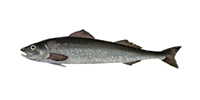Thank you for visiting the Seafood Selector. EDF is planning a new approach to providing information to consumers about good seafood choices. Please come back soon for updates.
Sablefish

Sablefish
Recommended servings per month
| Contaminant | Men | Women | Kids 6-12 | Kids 0-5 | |
|---|---|---|---|---|---|
| Sablefish/Black Cod | Mercury | 4+ | 4+ | 2 | 2 |
Eco details:
- Sablefish populations are healthy, and the fishing method (bottom longlines) produces little bycatch or harm to bottom habitat.
- The Alaskan sablefish fishery is operated under an innovative 'catch share' system, which allows fishermen to work under safer conditions and get better prices for their catch while conserving stocks.
- West Coast sablefish are now managed under a similar management plan as well. Bycatch is down 75%, and conservative catch quotas have limited the catch of overfished rockfish. Additionally, an innovation boom in gear design and fishing behavior has helped trawlers avoid bycatch hotspots and keep sensitive species out of nets.




